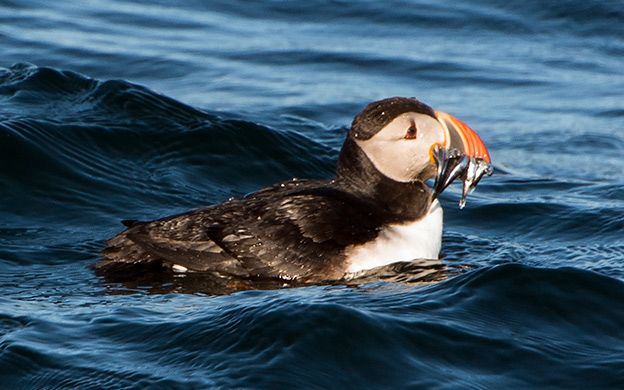Processing Your Payment
Please do not leave this page until complete. This can take a few moments.
- News
-
Editions
View Digital Editions
Biweekly Issues
- October 20, 2025
- October 6, 2025
- September 22, 2025
- September 8, 2025
- August 25, 2025
- August 11, 2025
- + More
Special Editions
- Lists
- Viewpoints
- Our Events
- Calendar
- Biz Marketplace
Power to the puffins of Eastern Egg Rock
 Photo / Jim Neuger
National Audubon Society's Puffin Project is focused on three Maine islands, including Eastern Egg Rock.
Photo / Jim Neuger
National Audubon Society's Puffin Project is focused on three Maine islands, including Eastern Egg Rock.
Watching “Titanic” the night before may not have been the best idea, but it took only a minute to get sucked right back into the story until its bittersweet end three hours later.
The next day at New Harbor on Maine's mid-coast, my other half and I boarded a Hardy Boat Cruise for a 90-minute puffin-watching excursion run in cooperation with the National Audubon Society's Project Puffin, which has a visitor center in Rockland. Project Puffin was launched in 1973 to restore puffins and other seabirds to historic nesting spots in the Gulf of Maine.
The destination? Eastern Egg Rock Island, a seven-acre treeless tract of land located in outer Muscongus Bay. Designated the Allan D. Cruickshank Wildlife Sanctuary, it's home to the world's first restored seabird colony. The only humans there are the few researchers camping out for weeks at a time.
As the boat engines cranked up and the winds began to blow, passengers found their seats (adventurers in front and on the upper deck, amateurs below under cover), rented binoculars (we had our own) and grabbed complimentary ginger candies and seasickness bags (fortunately, none appeared to be needed).
Soon after departure, our Audubon guide began the lesson with an introduction to island nesters, from puffins to terns to gulls to cormorants, as a crew member did a show-and-tell with diagrams. We learned that terns are angular, wispy fliers, while Atlantic puffins — orange-beaked and -footed cuties — return to coastal areas to breed and nest in cliff-top colonies.
Sadly by the late 1800s, hunters had killed off all the puffins in the area. Project Puffin aimed to bring them back to Eastern Egg Rock by transplanting young chicks from Newfoundland reared in artificial sod burrows, in hopes that they would return after two to three years at sea to breed. It worked, and now more than 1,000 puffin pairs nest on three Maine islands, including Eastern Egg Rock.
As the boat neared the island, sightings started from all sides called out by our Audubon guide like horse-racing announcer Larry Collmus at Belmont Park: Puffin flying in at 10 o'clock! 12 o'clock, now 1 o'clock, heading towards the islands! Puffin at 3 o'clock on the water, diving down for food, watch to see where he emerges! Quick! At 9 o'clock heading for the island!
It was amazing how quickly these funny-faced avians that resembled flying penguins zipped through the air. Though we didn't see huge colonies on the rocks as one would in a David Attenborough nature documentary, this was a rare opportunity to view these amazing creatures up close. Getting the perfect picture paled by comparison, even for social-media bragging rights.
On the way back, we learned more from our guide, a real ham in mimicking the cow-like sound puffins make in their underground burrows and quips about having a “swell” time on the waves. Though I refrained from buying puffin keychains, socks or other merchandise for sale, I contributed a small sum to the Project Puffin collection jar to support a worthy and noble cause.
Mainebiz web partners

The Giving Guide
The Giving Guide helps nonprofits have the opportunity to showcase and differentiate their organizations so that businesses better understand how they can contribute to a nonprofit’s mission and work.
Learn More
Work for ME
Work for ME is a workforce development tool to help Maine’s employers target Maine’s emerging workforce. Work for ME highlights each industry, its impact on Maine’s economy, the jobs available to entry-level workers, the training and education needed to get a career started.
Learn More
Groundbreaking Maine
Whether you’re a developer, financer, architect, or industry enthusiast, Groundbreaking Maine is crafted to be your go-to source for valuable insights in Maine’s real estate and construction community.
Learn more-
The Giving Guide
The Giving Guide helps nonprofits have the opportunity to showcase and differentiate their organizations so that businesses better understand how they can contribute to a nonprofit’s mission and work.
-
Work for ME
Work for ME is a workforce development tool to help Maine’s employers target Maine’s emerging workforce. Work for ME highlights each industry, its impact on Maine’s economy, the jobs available to entry-level workers, the training and education needed to get a career started.
-
Groundbreaking Maine
Whether you’re a developer, financer, architect, or industry enthusiast, Groundbreaking Maine is crafted to be your go-to source for valuable insights in Maine’s real estate and construction community.
ABOUT
NEW ENGLAND BUSINESS MEDIA SITES
No articles left
Get access now
In order to use this feature, we need some information from you. You can also login or register for a free account.
By clicking submit you are agreeing to our cookie usage and Privacy Policy
Already have an account? Login
Already have an account? Login
Want to create an account? Register
Get access now
In order to use this feature, we need some information from you. You can also login or register for a free account.
By clicking submit you are agreeing to our cookie usage and Privacy Policy
Already have an account? Login
Already have an account? Login
Want to create an account? Register







Comments